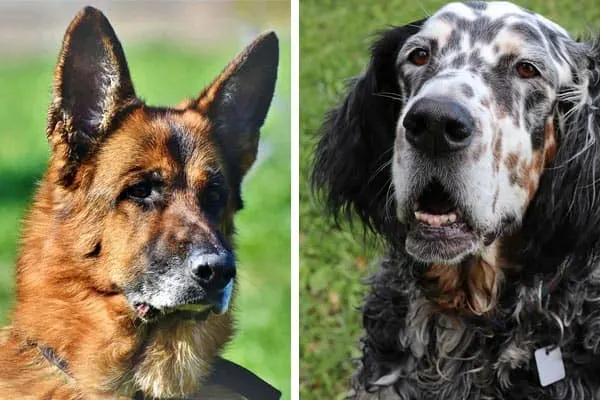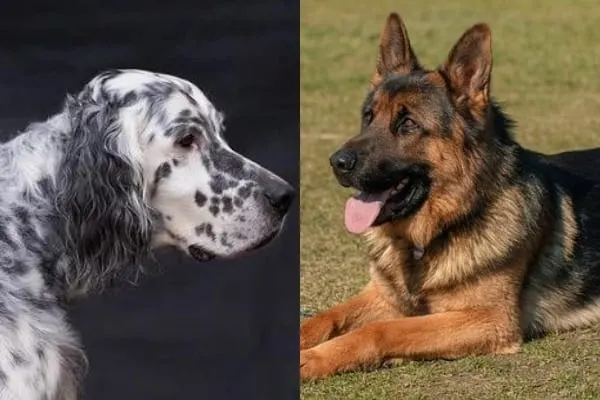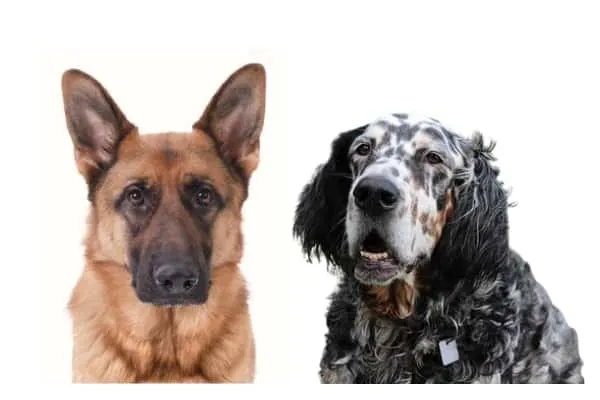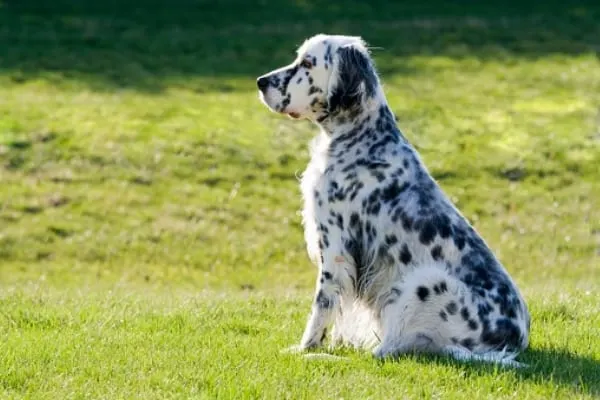The Rare English Setter German Shepherd Mix: How to Best Solve the Mystery
How often do you see a German Shepherd and an English Setter in the same movie? Probably never. Not designer dogs and occupying seemingly opposite jobs, you would be hard-pressed to find a deliberate cross between the two breeds.
Nevertheless, an English Setter German Shepherd combines excellent physical and temperamental characteristics of two dog types that make excellent family pets.
An English Setter German Shepherd mix with equal contributions from both parents will combine the desirable qualities of a sporting dog and a herding breed.
Both parents have distinctive and attractive physical attributes, creating a mix with a black and tan or tricolor flat, soft, medium-long coat, half-prick ears, a medium-large build, and a fringed tail. Your Setter Shepherd mix will be an active, alert, and driven dog with great athletic ability, intelligence, and joy.

What is the most probable origin of the English Setter GSD mix?
No one is sure when the English Setter and German Shepherd mix originated and whether the crossbreed ever occurs from purposeful matings or strictly by accident.
The English Setter is an older breed
The English Setter had origins approximately two or three hundred years before Max von Stephanitz wrote the first GSD standard based on show champion Hektor Linksrhein in 1899.
According to Largedogbreedz.com, the English Setter has its true origins in France in the 1500s with selective crosses between native Pointers and the Spanish Pointer. Hunters brought the mixed Pointers to England and Wales in the 1600s and proceeded to outcross them with Water Spaniels and Springer Spaniels.
These hunters also selected dogs that assumed a crouched or lying down position rather than an upright “point” to indicate a bird’s location. Setting prevented dogs from getting entangled in the nets historically used in gamebird hunting. Although the dogs would eventually assume an upright position to become more visible in high grass, the term setter stuck.
Edward Laverack began some of the most important developments of the English Setter from a 35-year-old family line beginning in 1825. He solidified the gold standard for English Setter conformation.
R. LL. Purcell Llewellyn picked up where Laverack left off, but focussed more on a performance dog. The Llewellyn Setter would fast become one of the most coveted and prestigious English Setter lines.
Field Setters typically are smaller with sparser coats and more ticking and patches than their show ring counterparts.
Serious English Setter breeding with British imports began in America in 1872 followed two years later by the arrival of the first Laveracks. The English Setter joined the AKC in 1884.
In 1862, setters had three major groupings
- Black and tan
- Irish
- English
As of 1873, the setter groupings became official breed distinctions
- Gordon Setter
- Irish Setter and Irish Red and White Setter
- English Setter

Presenting a review of GSD history
German Shepherds sprang from herding dogs that accompanied Shepherds and their flocks of sheep across central Europe.
The dogs responsible for the German Shepherd’s foundation split from the French Berger Picard and five Italian herding breeds around 1859.
German Shepherds remain in the same genetic cluster as French and Italian herding dogs, the New World Clade, separated by a couple of clusters from the Collies and Belgian Shepherds.
German Shepherds were proficient sheepherders whose primary jobs were to keep flocks from straying into forbidden or hazardous areas. When a GSD tends livestock, she controls with a roving or loose eye in contrast to the Border Collie’s hard or strong eye.
The GSD came to the United States in 1907 and became a member of the AKC in 1913.
Just like the English Shepherd, working lines of German Shepherds look much different than show dogs. Show animals can be heavier than working dogs and tend to have a classic saddle pattern of black and tan with a more luxurious coat and sloping back. Working dogs are more often sable or dark in color with blanket patterns of black.
Will your dog be sweet-natured?
Temperament is among the most challenging qualities to define and predict in dogs, even within a breed.
English Setters are typically friendly and have a steadiness that withstands commotion and loud noises. They are very active and yet attach easily to people. An English Setter’s close bonds with his family will not prevent him from being a little wicked and somewhat stubborn.
German Shepherds are intense and driven yet bond readily to their family, especially those they respect. A GSD often chooses one favorite person and sometimes needs encouragement to engage with multiple household members.
You can expect your Shepherd Setter mix to inherit personality quirks common to both parent breeds.
- Hard-working
- Loyal
- Affectionate
- Active and energetic
- Playful
- Cool but generally friendly
What will your dog’s guard potential be?
English Setters, like many gun dogs, do not make good guard dogs. However, Setters tend to be exuberant around visitors, announcing arrivals with a forceful bark.
A German Shepherd is the poster child for a defense dog or security patrol. Although most do not attack unless provoked, Alsatians are highly protective and territorial, making them exceptionally adept at deterring unwelcome guests. Some German Shepherds are friendly with people their owners accept, but many are standoffish even with frequent visitors.
Your GSD Setter hybrid will be an excellent watchdog but may be unlikely to attack or bite. She will probably be cordial with your friends, readily accepting overtures of affection.
Getting along with others may be a challenge
English Setters are friendly with other dogs and great with children, but German Shepherds have a history of same-gender dog aggression. Your mix will show a moderation of the Shepherd parent.
Other Pets
- High predatory instinct with small animals – Rodents, birds, and possibly, toy breed dogs and cats
- Friendly with dogs she grows up with
- Will get used to dogs in the household
- If well-socialized should play well with other dogs close to her own size.
Children
- Friendly with your friend’s children
- Mildly protective of children in the family
- Better with children over 7 years old – Large and energetic dog who may not be careful around toddlers and infants
- Needs constant supervision around small kids

The German Shepherd English Setter is an attractive mix
Although the AKC describes the English Setter as a medium-sized dog, she is about the size of a German Shepherd. English Setters are 23 to 27 inches tall and weigh 45 to 80 pounds, and the GSD is 22 to 26 inches tall at the shoulders and weighs 50 to 90 pounds.
English Setters are balanced and almost the same length and height. Ears are of medium length and lay close against an oval-shaped head.
An English Setter has a well-defined bridge between muzzle and forehead, a moderately deep snout, dark eyes, a long arched but strong neck, and rather short but well-feathered tail.
A Setter should give an impression of grace, symmetry, steadiness, and strength. The gait is powerful, efficient, and ground-covering with long-reaching strides.
English Setters are the speckled breed of the Setter group, and Belton is the term fanciers use to refer to the ticking on a white base. However, Setters branched based on requirements of differing terrains and not color.
- Blue Belton – Black specks; the dog’s white base makes her appear bluish.
- Lemon Belton – Dilute liver specks; equivalent to Isabella GSD
- Orange Belton – A shade of tan flecks; recessive color in English Setters but extremely common because show-goers selected for it in the 1940s and 1950s.
- Chestnut Belton also called Liver Belton- Brown or liver specks; recessive gene; because of the dilution of black, liver dogs have light-colored eyes.
- Tricolor – Dog has two colors in addition to white. Often, the third color is tan.
German Shepherds also have a pronounced stop, but where the Setter’s skull is rather flat, the GSD has a slight dome. German Shepherds have upright ears and dark almond-shaped eyes with a long and slightly square muzzle.
They have a long and powerful neck and sloping shoulders with a build moderately longer than tall. A GSD should give an impression of nobility, focus, and boldness, with a long-reaching stride and power-driven efficient gait.
German Shepherds have standard and nonstandard colors.
Standard
- Black and tan
- Red and tan
- Blue, blue bicolor, and blue & tan – fault; dilution gene affects black pigment
- Liver, liver bicolor, and liver & tan – Liver or brown gene prevents expression of any black; fault
- Isabella, Isabella bicolor, Isabella & tan – Isabella is a tawny to lilac shade and results from the recessive liver gene combined with a dilution.
- Solid Black
- Bicolor – Black dog with tan or red points
- Sable – Indeterminant gray, brown, and black without the classic saddle or blanket pattern; dominant color in GSD
Nonstandard
- Solid white
- Panda – Black & tan dog with 30% or more white; specific mutation
Your Setter GSD will blend the quality of the parents
- Head – medium with a fairly round face, may or may not have a slight dome-shaped forehead
- Long rather square-shaped muzzle, lips are droopier than they would be for a purebred GSD.
- Ears probably semi-prick but may lay down or be the rose.
- Long powerful neck
- Broad sloping shoulders
- Level or slightly sloping back
- Length:height ratio = 10:9
- Short coat with fringes of hair around ears, tail, and maybe some on the belly
Your dog can be a wide range of colors.
- Black and tan
- Blue Belton
- White with black patches or ticking
- Tricolor- red and black with white
- Chestnut Belton

How Will Your German Shepherd English Setter Mix Survive The Weather?
English Setters have a double coat composed of long silky outer hair and a moderate fluffy undercoat.
People who want to show a Setter will often scissor the dog. Those who wish the hair to lie flat and show off the light shades that judges prefer will strip the coat. Stripping a Setter is different than the process for a wire-haired terrier. English Setters with their original hair tolerate both cold and warm weather moderately well.
German Shepherds have a dense double coat. The outer coat can be short, medium, or long, and typically consists of coarse guard hairs. The undercoat is thick and woolly. German Shepherds tolerate frigid cold and hot weather remarkably well.
Grooming a Shepherd does not involve any clipping. You keep the coat kept in good condition through brushing and occasional baths.
Your mixed dog will have a short coat with a moderate amount of underfur. You will mostly want to brush your pet at least twice a week and comb the long tufts if there are any to keep them free of mats.
How much exercise should you plan?
Both the English Setter and GSD are active dogs with quite a bit of stamina. They need up to two hours or more of exercise every day, and so does your mix.
Your dog may or may not acquire natural herding or setting abilities from either of his parents, but there are plenty of activities in between at which he can excel. Many of the following exercises have the additional benefits of providing mental stimulation.
- Agility
- Jogging
- Hiking
- Shutzhund
- Flyball
- Geocaching – Unlike hounds, Setters do not put their noses to the ground but track airborne scents. Geocaching turns your pet’s sniffing talents into a game whereby you both can find treasures.
- Showing – Several clubs cater to people who want to show their mixed-breed dogs.
Your Setter Shepherd will be healthy
German Shepherds can live 9 to 12 years and English Setters similarly 10 to 12 years. Your mix will likely have a life expectancy of 11 to 13 years. There are a few health problems you may expect to see occasionally in your crossbreed.
- Hip and elbow dysplasia (GSD and ES) – Both breeds are very prone; The GSD has close to a 20% incidence of dysplasia while the English Setter has a 15% occurrence of hip and elbow problems.
- Deafness (ES) – Dogs with little pigment are at greater risk
- Low thyroid (GSD and ES)
- Bloat (GSD) – Stomach bloats with gas or fluid and then can twist
- Hemophilia (GSD) – Bleeding disorder
- Von Willebrand’s (GSD) – Clotting disorder
Your English Setter German Shepherd Mix is smart
German Shepherds have a well-earned reputation for intelligence. They are among the brightest canine stars, ranking in the top three smartest dogs with Poodles and Border Collies, according to Animalwised.com which quotes dog psychologist Stanley Coren.
English Setters are of above-average working smarts, per Dogsbreedslist.info. Probably because of their willfulness, English Setters scored lower than the other setters, but were on par with Min Pins and Affenpinschers.
If Stanley Coren had ranked non-AKC dogs, your mix would probably have qualified as an excellent working dog.
- Intelligence ranking around No. 18 – On the level with the English Cocker Spaniel and German Shorthaired Pointer.
- Great work ethic
- Easy to train for the confident owner- Picks up commands readily but has a forceful personality that requires strong leadership.
- Above-average instinctual intelligence – Ability to learn from his environment and think for himself.

Summary
The English Setter German Shepherd mix is an energetic and playful large-sized dog with a beautiful work drive and fairly good versatility. Gundog qualities moderate a German Shepherd’s intensity and suspicious nature against strangers at the same time the GSD improves an English Setter’s focus and power.
The unique mix of GSD and ES is a pleasant-looking, cheerful dog who makes a loyal companion. Her ears will help give her a jovial air as they are likely only partially to stand up, and her eyes will be smart and lively. She will probably be black and tan, tricolor like a beagle, or mostly white with black patches or ticking.
English Setter
Note the English Setter’s long hair, but its flat appearance illustrates the relatively thin undercoat. The wolf has a double coat more reminiscent of a German Shepherd, short, dense, and plush.
In this Youtube Video, you can see the English Setter’s feathering on tail and legs. Ears lay down, and the muzzle is long, deeper than a GSD’s, and has relatively pendulous lips.
Finally, the Setter is largely white with brown flecks. It is common for Setters to have more color on their faces than there bodies, although not always the case.
This English Setter is a liver Belton, and the wolf, which may be a hybrid, is agouti or wild sable, a common color in the GSD as well as animals like coyotes and deer. As long as they are active, English Shepherds can tolerate cold conditions. They do not do well if you leave them outside for long periods.
A Blue Belton tricolor English Setter exemplifies its historical job of setting and flushing low-flying game birds like grouse and pheasants.
Field dogs have more color and a less luxurious coat than show animals. Shorter coats are better for burs, and the color makes it easier for hunters to spot their dogs.
easily
- Athletic
- Attentive
- Good sense of smell
- Stamina
- Joyous, great attitude
German Shepherd
In this video, German Shepherds exhibit the following attributes, many of which they will pass to your puppy. Note the dogs, typical of working lines, are sable or bicolor with a lot of solid dark colors.
- Athleticism
- Speed
- Strength and power
- Smooth efficient movement
- Joy of working
- Focus and drive
- Agility
- Obedience






























